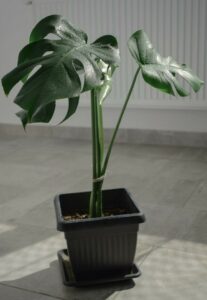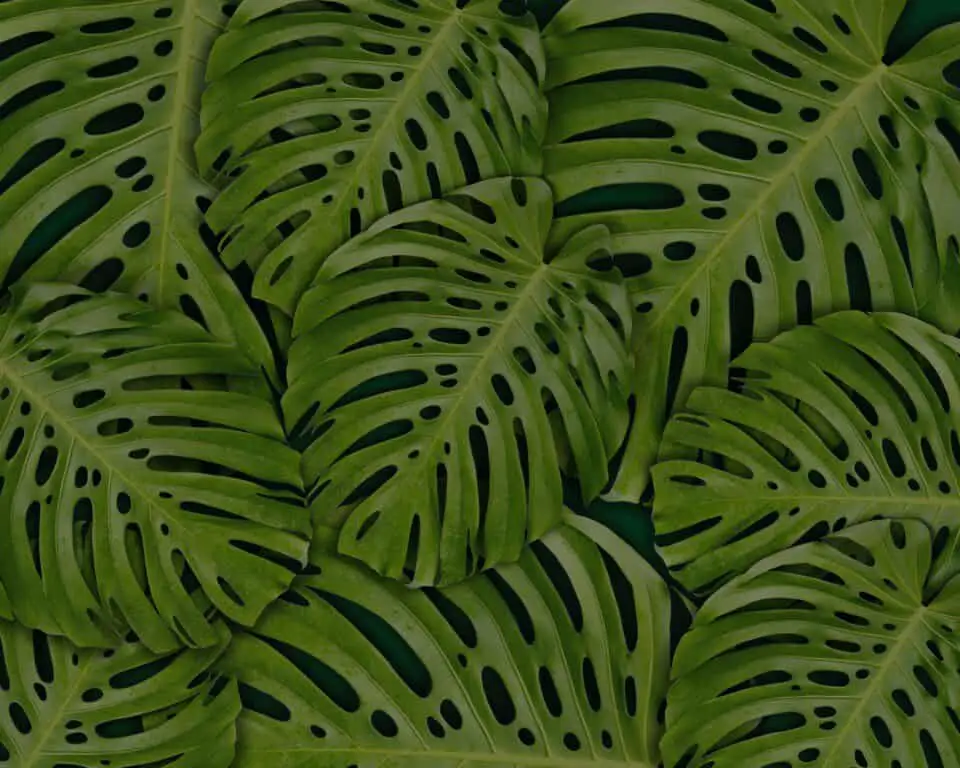Some links in the post are affiliate links and I get a commission from purchases made through some links found in the post.
While light is a vital element for the growth of your monstera plant, sunburn can occur if your monstera is exposed to an intense amount.
The best way to save your monstera from sunburn is to relocate its position. If it is positioned close to a window that receives intense light, then your monstera plant should be relocated.
It is important to be well informed on the light requirement of a monstera plant as well as the symptoms associated with sunburn.
As you progress down this article, you will learn how to save a monstera with sunburn and some preventive measures you can take to avoid this problem.
What are Signs that your Monstera has Been Sunburnt?
You may begin to observe some abnormal physical changes in your monstera and to know if this is a result of sunburn, then you have to know some of the symptoms of a sunburnt monstera.
Identifying these symptoms early will make reviving your plant easier.
Presence of Burn Spots
 Intense light destroys the soft tissue on your monstera leaves and an indication of this burn will be a dry brown spot on your leaves.
Intense light destroys the soft tissue on your monstera leaves and an indication of this burn will be a dry brown spot on your leaves.
Before browning, you will notice some grey spots which are early indications of sunburn, and at this stage, rescuing your plant will not require a lot as the burn has not gone beyond the tissue level of your leaves.
When the burn spreads deeper, then the grey spots turn brown. These spots are common to the upper leaves which are more exposed to sunlight.
Monstera Leaves Become Bleached
On exposure to intense sunlight, your monstera leaves may appear to be bleached or washed out.
It’s going to look like the color has been drained out of it and it will have a texture similar to that of paper.
This can also be an indication of potassium shortage in your soil or overwatering, so you mustn’t misread the signs.
Wilting of Leaves
Your once upright monstera leaves will now start to sag as a result of sunburn.
Direct light on your monstera plant will cause dehydration and dehydration is an indication that your monstera leaves will not get adequate water and nutrients will not be transported to parts of the plant actively.
Stunted Growth
As we have explained earlier, exposing your monstera plant to intense light can cause dehydration.
Water is an important factor that determines the growth of your monstera plant, if you strip the water off this plant, necessary nutrients will not be transported as well and with these two basic factors lacking in your plant, there will be no observable growth.
Yellowing or Browning of Leaves
You may observe brown spots on your leaves at first, but with continuous exposure to direct sunlight, your monstera leaves will begin to turn brown or yellow.
This discoloration starts from the edges and then spread throughout the leaves or sometimes they remain at the edges.
This effect strips the natural green color off your monstera leaves and this green color is a result of chlorophyll which aids in photosynthesis. Without chlorophyll, your laves cannot photosynthesize and they begin to die gradually.
Crispy Leaves
When leaves dry out they feel crusty just like paper and touching the leaves may cause them to break.
This feeling is more prominent in areas that have been discolored, at this point the damage by sunburn is severe and cannot be fixed, with time the leaves will fall off the plant.
Other leaves that have not been damaged this badly can still be restored.
How to Save a Monstera with Sunburn
Taking notice of any of these symptoms of sunburn calls for immediate action before the damage gets severe.
When restoring your monstera plant, you will have to be patient and observant of the applied techniques to produce results. You can follow some of these steps to save your monstera plant.
Relocate your Plant
It has already been established that direct sunlight is the primary cause of sunlight, the only way your plant has access to this amount of sunlight is because they are positioned close to an area that receives direct sunlight.
A monstera is an indoor plant that requires medium indirect light for proper growth and this can be achieved by positioning your plant a few feet away from your window.
If the light is still too intense at the final location, you can consider putting a shade over your monstera to control the amount of light it receives. You can learn more about the light requirements for a monstera plant.
1) Use Grow Lights
Grow lights are artificial lights that can be used as an alternative to sunlight.
These grow lights vary in types, sizes, and shapes, they are helpful if you live in an apartment that supplies very little light it will also be very helpful in regulating the amount of light your plant receives.
Here are some of the best grow lights for your monstera plants.
2) Give your Monstera Adequate Water
Direct sunlight means there will be a lower amount of water in your soil mix and this water will not be enough to be supplied to your leaves.
After changing the location of your monstera you can feed it some water to hydrate it and keep the water balance normal.
Filtered water should be used and be careful not to overwater this plant, a good way to guarantee this is to make sure that the soil is moist and not soggy.
3) Provide the Right Environmental Requirements
Apart from sunlight and water, your monstera plant needs to be grown under the right temperature and humidity.
The ideal temperature for growing this plant is between 15.5 and 26.6 degrees Celsius (60 to 80 degrees Celsius), and the ideal humidity for this plant should be between 40% and 60%.
If the environmental factors fall above or below these ranges, your monstera plant may not do so well.
4) Fertilize your Plant
 If your monstera has been sunburnt it will lack some major nutrient that will help its recovery and growth.
If your monstera has been sunburnt it will lack some major nutrient that will help its recovery and growth.
If there is a mild discoloration of your monstera leaves then you should supply your plant with a fertilizer that contains nitrogen and potassium.
Nitrogen helps in the production of chlorophyll which helps with photosynthesis and potassium is important for utilizing chlorophyll for photosynthesis.
How Can you Prevent your Monstera from Being Sunburnt
With intense sunlight being the cause of sunburns, the best solution is to keep your monstera plant away from direct light, but there are also other steps you can take to ensure that sunburn never affects your plant.
1) Placing your Monstera in the Right Window
You may have observed that the light intensity differs at the different windows in your house.
The southern window is known for receiving a high amount of daylight sun which is not the best for your monstera plant as it can cause sunburn, the northern window, however, supplies a very low light that will be inadequate for your monstera plant.
The eastern window is the best place to position your plant as it receives a generous amount of morning sun which is great for your monstera. The morning sun is not intense and it supplies just the right amount of light for this plant.
2) Control the Amount of Light Coming Through your Window
If the intensity in the position of your monstera plant is great, you can use sheer curtains or regular blinds to control the amount of light your plant receives.
An important criterion to take into consideration is the thickness of the curtain, the curtain should not be too thick as it will not allow light to get to your monstera at all.
Another method you can consider is using protective films to filter the light passing through a window. UV protective films are available in different strengths and your best option is one that allows sufficient light to pass through.
3) Supply Moisture to your Monstera Plant
Keeping this plant moist at all times is necessary for growth and good health, it is also a way to maintain the humidity level of this plant.
Supplying moisture can be done by misting your plant manually with a spray bottle, or you can use a humidifier to get this job done.
4) Harden your Plant
Plants usually emerge from dormancy after winter, and at this stage, they are more likely to be sunburned.
The best step to take is to gradually introduce your monstera to light after this period, it can start with keeping it far away from a window and then steadily bringing it closer. This will allow it to adapt to a new light intensity better.
5) Fertilize your Plant in Early Spring
Early spring is known to be the best time to fertilize your plant. This is because in summer, your monstera grows more with the application of fertilizer and these new growths are vulnerable to sunburn.
Should I Cut off Sunburned Monstera Leaves?
Yes, you should cut off a completely sunburned monstera leaf. The only exception to this is if you have some leaves that have not been totally affected by this burn, and in this case, you will need to trim out the affected area on the leaves.
In a case where the sunburn affects a whole leaf, you will need to cut it off as the affected leaf cannot be restored. Leaving it on the parent plant to heal will not help as it will eventually wilt and fall off.
Will my Monstera Recover from Sunburn?
This depends on the level of damage done to the plant. If it’s mild damage, then your monstera can quickly recover when provided with the right conditions, but in a case where serious damage is done, it will take some time for recovery to happen.
As for the damaged leaves that will be cut off, your monstera plant will synthesize energy to grow new leaves that will replace the damaged ones. Recovery of this plant will be speedy when subjected to the right conditions.
Final Thoughts
 If you have a monstera plant affected by sunburn there are some steps you can take to ensure that your plant recovers from the damage done.
If you have a monstera plant affected by sunburn there are some steps you can take to ensure that your plant recovers from the damage done.
We have provided a detailed guide on how to help your monstera plant recover from sunburn as well as how to prevent this problem in the future.

